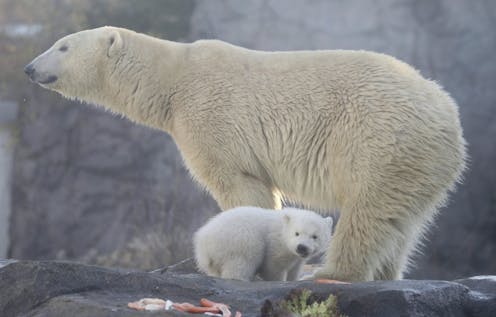
The global climate is changing and the Arctic is warming rapidly. These are objectively true statements that most people have come to accept.
But it is also true that Earth’s climate has never been stagnant and climate anomalies have been frequent throughout the past.
How then, do we understand our current situation relative to past climate shifts? Are the impacts of modern climate change comparable to those of the medieval warm period (MWP) or the little ice age (LIA)?
Our recently published study in Anthropocene demonstrates a much more substantial impact to polar bears resulting from recent climate change compared to observations over the last 4,000 years. This suggests that current climatic changes are, indeed, unprecedented in human history.
Ecosystem background
Predators at the top of the food chain, like polar bears, reflect changes across the entire ecosystem, all the way down to microscopic algae.
In the Arctic, the base of the food web is sourced from two categories: sea ice-associated algae and open-water phytoplankton, which are distinguishable through their carbon isotopes.
In our study area — centred on Lancaster Sound in the Canadian Arctic Archipelago — the food web is fed by a combination of both sea ice algae and phytoplankton. We can assess the relative importance of these two sources through the stable isotopes incorporated into the tissues of animals.
The relative abundance of carbon isotopes does not change as they are transferred through the food web, so these isotopes tell us about the carbon sources at the base of the food web. Nitrogen isotopes do change as they are passed up the food chain, which tells us who is eating whom.
Results from our study
In our study we examined stable carbon and nitrogen isotopes in polar bear bone collagen.
The polar bears were all from the Lancaster Sound sub-population and spanned the last 4,000 years. We acquired samples of modern polar bear (1998-2007) obtained through hunting and we were able to compare them to samples from archaeological excavations conducted in the region.
The span of time captured by the archaeological samples was vast, but by dividing them into time bins associated with the cultural traditions in the region we were able to compare the samples across time before present (BP): pre-Dorset (4000-2800 years BP), Dorset (1500-700 BP) and Thule (700-500 BP).
The Dorset/Thule cultural transition occurred at the onset of the medieval warm period, so a comparison of these time bins allows us to look at the state of the food web before and during a known climate shift. The Thule time bin also extends into the beginning of the little ice age giving us a glimpse into that period as well.
What it all means
First, the good news. The results of the nitrogen isotopes showed that throughout time, 4,000 years BP to the present, the structure of the Lancaster Sound food web was relatively unchanged. Polar bears eat seals, seals eat cod, cod eat zooplankton, et cetera. There were no surprising shifts in the diets of polar bears despite past and present climate change. This is comforting.
The results of the carbon isotopes tell a less encouraging story, however. Throughout the four millennia encapsulated by the ancient time bins, we saw stability in the mixture of sea ice algae and open water phytoplankton. We did not detect a difference in the origin of carbon at the base of the food web resulting from the medieval warm period or the little ice age.
The modern samples, however, showed a significant difference in the source of carbon, resulting from a greater proportion of open water phytoplankton and less reliance on sea ice algae.
Evidence of a warming climate
Sea ice is an important habitat in the high Arctic. For polar bears it is a platform for hunting. For ringed seals, the primary prey of polar bears, it is a platform for denning and raising young.
The algae that grows in association with sea ice is also very important for jumpstarting biological productivity before the open water season. Our study shows that the loss of biological productivity associated with sea ice is unprecedented on a very long timescale.
Archaeological materials can provide valuable context to the ongoing climate discussion. Much of the valuable work being undertaken is tracking ecosystem changes on a short timescale, seasons to decades. But as we have demonstrated, the Arctic has already changed, so we should not always assume that we are looking at a pristine or undisturbed state.
Adding a lens that looks back into the distant past gives resolution and context to our collective understanding of our situation.
In this case, we have illustrated the magnitude of difference occurring in the modern Arctic, relative to past climate anomalies. The medieval warm period and onset of the little ice age were not visible in the isotopes of the Lancaster Sound food web but modern warming is very apparent. We can, therefore, not dismiss calls to action on climate change on the basis that the climate has always fluctuated.
This research received funding from an NSERC Discovery grant and the Canada Research Chairs program.
This article was originally published on The Conversation. Read the original article.







